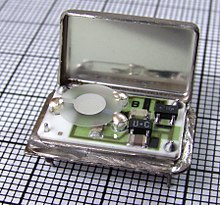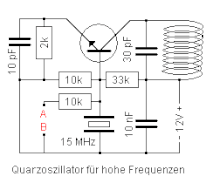Crystal oscillator
This article is currently in the quality assurance in WikiProjekt Electrical Engineering of the portal Electrical Engineering . If you are familiar with the topic, you are welcome to participate in the review and possible improvement of the article. The exchange of views on this can be found in the discussion ( enter the article “quartz oscillator” ).
A quartz oscillator is an electronic circuit for generating oscillations that contains a quartz oscillator as a frequency-determining component . In the narrower sense, a quartz oscillator is a ready-made oscillator circuit that is built into a housing together with the frequency-determining oscillating crystal and is available as a standard component.
Crystal oscillators are very precise in terms of their frequency (number of oscillations per period ) and have deviations of typically less than 100 ppm . Other common electronic oscillator circuits, e.g. B. those with LC resonant circuits are much less precise with deviations from the nominal frequency of more than 1% (10,000 ppm). In practice, the crystal oscillator can often be found as a clock generator for processors , microcontrollers , radio devices and in crystal watches .
Inexpensive but less precise ceramic resonators are alternatives with identical areas of application . Furthermore, programmable MEMS oscillators are available whose frequency-determining element is a microsystem integrated in the semiconductor chip.
technical structure
Those used in crystal oscillator circuits oscillating crystals are usually crystal platelets , rods or forks (such as a tuning fork ), which can be brought by electrical current to mechanical deformations, which in turn generate an electrical voltage. The reaction is given by the mechanical vibration modes of the piezoelectric crystal.
A quartz oscillator is excited to particularly strong resonance vibrations at an alternating voltage of a certain frequency, its resonance frequency ( piezoelectric sounders also have this property ). With a suitable crystal cut, it is almost independent of environmental influences such as temperature or amplitude and is therefore used as a precise clock with a long-term stability better than 0.0001%.
Vibrating quartz plates have two electrical / mechanical modes that can be electrically distinguished:
- With series resonance , their apparent resistance to the alternating current is particularly low and they behave like a series circuit consisting of a coil and a capacitor.
- With parallel resonance , the apparent resistance is particularly great. Then they behave like a parallel connection of capacitor and coil with the special feature that no direct current can flow (quartz is a very good insulator).
The parallel resonance is about 0.1% higher than the series resonance. A comparable vibration behavior can also be found at three, five, etc. basic frequencies. A crystal with a resonance frequency of 9 MHz can be made to oscillate at 27 MHz or 45 MHz. Harmonic crystals especially suitable for this have an appropriate suspension so as not to hinder these harmonics.
The operating point of the quartz oscillator in the quartz oscillator lies between the above. Natural resonance. In this frequency range the quartz oscillator behaves inductively like a coil. Together with its nominal capacitive load, the crystal oscillator oscillates at its nominal load resonance frequency. Slight deviations from the nominal frequency can be generated or compensated for by changing / deviating from the nominal load capacity.
The frequency is slightly temperature dependent. For greater demands on the temperature response, there are temperature-compensated oscillators (TCXO - English Temperature Compensated Crystal Oscillator ). In most cases, thermistors are used, which generate a control voltage that counteracts the temperature-dependent frequency change of the quartz. The voltage generated in this way is usually applied to a capacitance diode , so that the changed capacitance corrects the frequency of the crystal oscillator.
If even higher accuracy is required, a quartz furnace is used. The quartz is built into a temperature-controlled housing in order to minimize the effects of ambient temperature. In it, the quartz is electrically connected to z. B. 70 ° C heated. This design is OCXO ( English Oven Controlled Crystal Oscillator ). The "X" stands for Xtal , the short form of Crystal .
species
Integrated circuit
These crystal oscillators are manufactured with a metal or plastic housing in the grid dimension of integrated circuits . They deliver a logic- compatible square wave (a clock signal) with a very precisely defined frequency. They require an operating voltage and contain all the components required for an oscillator. The frequency of these crystal oscillator components is usually printed in megahertz on the top of the housing. The inaccuracy of the frequency is given in ppm . The lower this inaccuracy, the more complex (and therefore more expensive) the component is.
Common designs for push-through mounting are DIP 14 (rectangular, see picture) and the shorter design DIP 8 (square). There are also crystal oscillators in smaller chip housings as surface-mounted devices (SMD). Usual supply voltages are based on the supply of digital circuits such as 1.8 V, 2.5 V or 3.3 V and the 5 V often used in the past for transistor-transistor logic (TTL).
Pierce circuit
In digital technology in particular, logic gates , usually inverters with Schmitt trigger inputs, are used to generate clock signals . The circuit in question is referred to as a Pierce circuit and is characterized by a simple structure without coils . The inverter stage U 1 , as shown in the adjacent figure, can also be part of integrated circuits (IC), whereby only the connection pins for the oscillating crystal X to be connected externally are led out on the IC (typically identified with designations such as XTAL ). This oscillator can also be implemented with the aid of CMOS inverter stages, which is why it is widely used in practice.
In this circuit, the quartz oscillates in parallel resonance and only allows oscillations in accordance with its fundamental frequency. The circuit can be used for all crystal frequencies between approximately 30 kHz and 10 MHz without major changes; the frequency generated can be changed slightly by varying the two capacitors C 1 and C 2 .
The second inverter stage U 2 serves as an amplifier stage and pulse shaping: U 2 generates a square wave at the output that can be used directly as a clock signal for digital circuits such as clocked flip-flops or microprocessors .
Discrete structure
This circuit is dimensioned for higher frequencies and generates - depending on the resonance frequency of the oscillating circuit - either 15 MHz or 45 MHz. The resonant circuit has to be tuned to the frequency of the odd harmonic of the quartz that you want to generate. The synchronization of the frequencies of the quartz and oscillating circuit can be recognized by the sudden change in voltage between measuring points A and B. What is striking about this circuit is the lack of visible feedback. Nevertheless, this circuit works because the transistor has internal capacitances both between collector and emitter and between base and emitter.
Function: If you were to replace the crystal with a capacitor of sufficient capacity (a few nF), you would have a transistor amplifier in common base , as is often used in VHF amplifiers. This circuit has no phase shift between the input at the emitter and the output at the collector. A small capacitance (a few pF is sufficient) between the collector and emitter can be used to create feedback that turns the amplifier into an oscillator .
In the adjacent circuit, the internal capacitance of the transistor between C and E is sufficient for this. However, this feedback creates a phase shift that is more at 90 ° than the required 0 °, because the input resistance of the transistor is not also a capacitor between the base and emitter. This is corrected with the small 10 pF capacitor on the left. The frequency of this oscillator is determined by the resonance frequency of the resonant circuit at the collector.
If you now replace the capacitor at the base - as shown - with an oscillating crystal, the oscillator can only oscillate when the base is "cold" in terms of alternating current , i.e. when the quartz element has a particularly low alternating current resistance . This is the case with series resonance and all odd multiples. At all other frequencies the amplification of the basic circuit is too low and the oscillations are not fanned.
Adjustable crystal oscillators
A quartz oscillator by connecting a trim capacitor can be changed in its frequency to a small extent (some ppm) is usually VXO ( English Variable Crystal Oscillator - the "X" stands for Xtal, the short form of Crystal.) Called. Before the availability of precisely manufactured quartz oscillators, such trimmers were necessary, for example, to calibrate the accuracy of quartz watches . If the crystal oscillator by electrical voltage trims, it is (VCXO English voltage controlled crystal oscillator , crystal oscillator with trimmable over voltage frequency) mentioned. TCVCXO ( English Temperature Compensated Voltage Controlled Crystal Oscillator ) or OCVCXO ( English Oven Controlled Voltage Controlled Crystal Oscillator ) stand for temperature-compensated or heated adjustable oscillators.
The control voltage can, for. B. counteract temperature dependencies or aging. The frequency can usually only be changed in the order of 100 ppm. They are often used in frequency generators , controllable oscillators in phase-locked loops and other high-frequency measuring and testing devices.
literature
- Bernd Neubig, Wolfgang Briese: The large quartz cookbook . Franzis-Verlag, Feldkirchen 1997, ISBN 3-7723-5853-5 ( Chapters as PDF [accessed on September 12, 2009] German standard work on quartz crystals and their wiring).
- Wes Hayward, Rick Campbell, Bob Larkin: Experimental Methods in RF Design . The American Radio Relay League, Newington CT 2003, ISBN 0-87259-879-9 .
Web links
- Eckart KW Moltrecht: Oscillator circuits with explanation. Archived from the original on March 4, 2016 ; accessed on February 13, 2017 .
- Fundamentals of Quartz Oscillators . (PDF; 256 kB); Application Note from Hewlett-Packard (English)
Individual evidence
- ↑ TCXOs - Temperature Compensated Crystal Oscillators Information page on the Wenzel Associates website, accessed on September 6, 2011
- ↑ Technical data sheet ( page no longer available , search in web archives ) Info: The link was automatically marked as defective. Please check the link according to the instructions and then remove this notice. , Integrated crystal oscillator, Epson Toyocom




